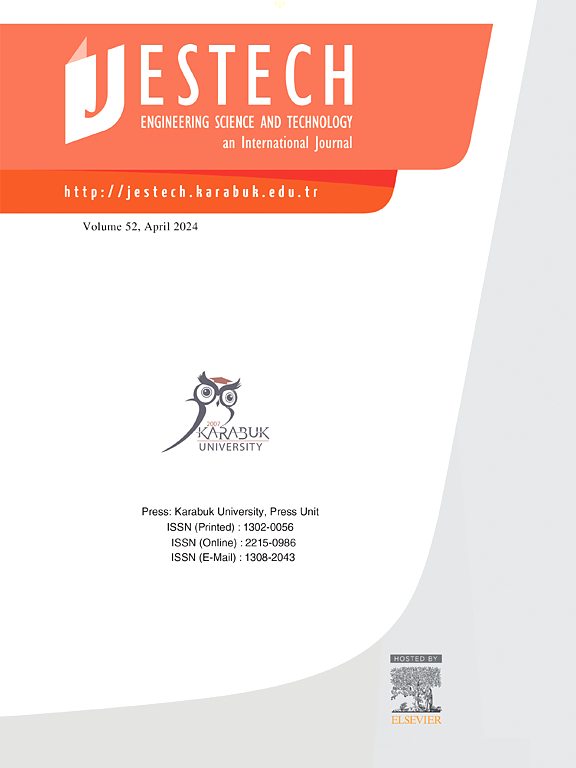Hybridization of the Snake Optimizer and Particle Swarm Optimization for continuous optimization problems
IF 5.4
2区 工程技术
Q1 ENGINEERING, MULTIDISCIPLINARY
Engineering Science and Technology-An International Journal-Jestech
Pub Date : 2025-05-17
DOI:10.1016/j.jestch.2025.102077
引用次数: 0
Abstract
The Snake Optimizer (SO), despite its reasonable performance in a variety of continuous optimization problems, struggles by inefficient exploration, stagnation in local optima, and a slow convergence. To improve exploration, accelerate convergence, and avoid local optima, the velocity vector of Particle Swarm Optimization (PSO) was integrated into the Snake Optimizer (SO), resulting in the proposal of the Snake Optimizer Particle Swarm Optimization (SO-PSO) metaheuristic method. To evaluate the applicability of the proposed SO-PSO method, it was evaluated on continuous numerical problems (CEC-2017) and seven real-world engineering problems, benchmarking its performance against contemporary metaheuristic algorithms, including WOA, PSO, GWO, EO, LSHADE, and SO. A comparative analysis of six metaheuristics and SO-PSO was conducted on 30 shifted and rotated benchmark problems across dimensions and population sizes of 30, 50, and 100, as well as seven engineering challenges with population sizes of 30, 50, and 100, each evaluated over 30 independent runs. According to the Friedman ranking results from 270 experimental tests on CEC17 functions, SO-PSO, WOA, PSO, GWO, EO, LSHADE, and SO achieved rankings of 1.62, 6.5, 5.91, 4.18, 1.98, 4.53, and 3.28, respectively. Regarding the results of the engineering functions, SO-PSO, WOA, PSO, GWO, EO, LSHADE, and SO achieved rankings of 1.82, 6.19, 3.95, 4, 3.38, 4.34, and 4.33, respectively. Besides, the proposed SO-PSO shows statistically significant difference from other methods in 96.42 % and 93.65 % of experimental tests obtained from Wilcoxon’s signed-rank test in CEC17 functions and engineering problems, respectively. Consequently, SO-PSO demonstrated superior performance over other metaheuristics based on experimental and statistical test results.

连续优化问题的Snake优化器与粒子群优化的杂交
尽管Snake优化器(SO)在各种连续优化问题中表现合理,但由于搜索效率低、局部最优停滞、收敛速度慢等问题而苦苦挣扎。为了提高搜索能力,加快收敛速度,避免局部最优,将粒子群优化(PSO)的速度矢量集成到Snake优化器(SO)中,提出了Snake优化器粒子群优化(SO-PSO)的元启发式方法。为了评估所提出的SO-PSO方法的适用性,对连续数值问题(CEC-2017)和七个实际工程问题进行了评估,并将其与当代元启发式算法(包括WOA, PSO, GWO, EO, LSHADE和SO)的性能进行了基准测试。对30个维度和人口规模为30、50和100的平移和旋转基准问题,以及7个人口规模为30、50和100的工程挑战进行了6种元启发式和SO-PSO的比较分析,每个挑战在30次独立运行中进行评估。根据270个CEC17功能实验的Friedman排序结果,SO-PSO、WOA、PSO、GWO、EO、LSHADE和SO的排名分别为1.62、6.5、5.91、4.18、1.98、4.53和3.28。在工程功能方面,SO-PSO、WOA、PSO、GWO、EO、LSHADE、SO的排名分别为1.82、6.19、3.95、4、3.38、4.34、4.33。此外,在CEC17函数和工程问题的Wilcoxon符号秩检验中,所提出的SO-PSO分别在96.42%和93.65%的实验检验中与其他方法有统计学差异。因此,基于实验和统计测试结果,SO-PSO算法表现出优于其他元启发式算法的性能。
本文章由计算机程序翻译,如有差异,请以英文原文为准。
求助全文
约1分钟内获得全文
求助全文
来源期刊

Engineering Science and Technology-An International Journal-Jestech
Materials Science-Electronic, Optical and Magnetic Materials
CiteScore
11.20
自引率
3.50%
发文量
153
审稿时长
22 days
期刊介绍:
Engineering Science and Technology, an International Journal (JESTECH) (formerly Technology), a peer-reviewed quarterly engineering journal, publishes both theoretical and experimental high quality papers of permanent interest, not previously published in journals, in the field of engineering and applied science which aims to promote the theory and practice of technology and engineering. In addition to peer-reviewed original research papers, the Editorial Board welcomes original research reports, state-of-the-art reviews and communications in the broadly defined field of engineering science and technology.
The scope of JESTECH includes a wide spectrum of subjects including:
-Electrical/Electronics and Computer Engineering (Biomedical Engineering and Instrumentation; Coding, Cryptography, and Information Protection; Communications, Networks, Mobile Computing and Distributed Systems; Compilers and Operating Systems; Computer Architecture, Parallel Processing, and Dependability; Computer Vision and Robotics; Control Theory; Electromagnetic Waves, Microwave Techniques and Antennas; Embedded Systems; Integrated Circuits, VLSI Design, Testing, and CAD; Microelectromechanical Systems; Microelectronics, and Electronic Devices and Circuits; Power, Energy and Energy Conversion Systems; Signal, Image, and Speech Processing)
-Mechanical and Civil Engineering (Automotive Technologies; Biomechanics; Construction Materials; Design and Manufacturing; Dynamics and Control; Energy Generation, Utilization, Conversion, and Storage; Fluid Mechanics and Hydraulics; Heat and Mass Transfer; Micro-Nano Sciences; Renewable and Sustainable Energy Technologies; Robotics and Mechatronics; Solid Mechanics and Structure; Thermal Sciences)
-Metallurgical and Materials Engineering (Advanced Materials Science; Biomaterials; Ceramic and Inorgnanic Materials; Electronic-Magnetic Materials; Energy and Environment; Materials Characterizastion; Metallurgy; Polymers and Nanocomposites)
 求助内容:
求助内容: 应助结果提醒方式:
应助结果提醒方式:


